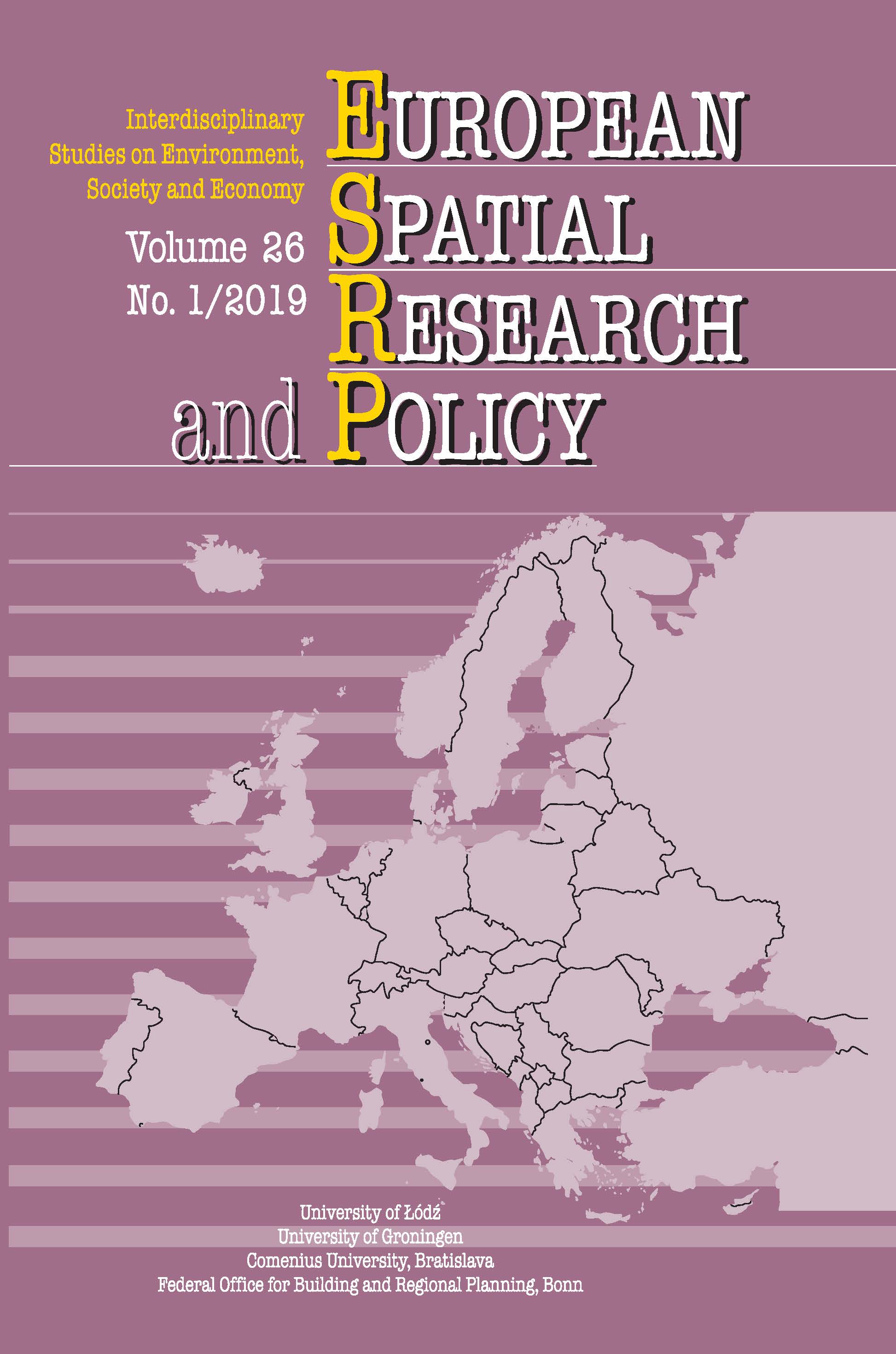Relative Accessibility of District Centres in Slovakia by Public Transport in 2003 and 2017
DOI:
https://doi.org/10.18778/1231-1952.26.1.02Keywords:
public transport, accessibility, direct connections, district centres, SlovakiaAbstract
Transformation of the transport system in Slovakia after 1989 has influenced the pattern of public transport. This article focuses on the analysis of public transport accessibility in district centres in Slovakia. The results show a decrease of connectivity in the network of direct bus and train connections and also a decrease in the number of direct connections between district centres in Slovakia in the period from 2003 to 2017. The main factors that have caused these changes include growing motorisation and individual automobile transport, zero-fare trains for selected categories of inhabitants since 2014, the construction of the motorway network, and the liberalisation of the public transport market.
Downloads
References
BRUINSMA, F. and RIETVELD, P. (1998), ‘The accessibility of European cities: theoretical framework and comparison of approaches’, Environment and Planning A, 30, pp. 499–521.
Google Scholar
BUČEK, J. and KOREC, P. (eds.) (2013), Moderná humánna geografia mesta Bratislava: priestorové štruktúry, siete a procesy, Bratislava (Univerzita Komenského, Prírodovedecká fakulta, Katedra humánnej geografie a demografie).
Google Scholar
EUROPEAN COMMISSION, (EC) (2011), Quality Framework for Services of General Interest in Europe. COM(2011) 900, Brussels: European Commission.
Google Scholar
FAN, Y., GUTHRIE, A. and LEVINSON, D. (2012), ‘Impact of light-rail implementation on labor market accessibility: A transportation equity perspective’, The Journal of Transport and Land Use, 5, pp. 28‒39.
Google Scholar
GEURS, K. T. and Van WEE, B. (2004), ‘Accessibility evaluation of land-use and transport strategies: review and research directions’, Journal of Transport Geography, 12, pp. 127–140.
Google Scholar
GOODALL, B. (1987), The Penguin dictionary of human geography. Harmondsworth: Penguin.
Google Scholar
GUTIÉRREZ, J. (2009), ‘Transport and accessibility’, [in:] Kitchin, R., Thrift, N., (eds.) International encyclopaedia of human geography. Amsterdam: Elsevier, pp. 410–417.
Google Scholar
HALDEN, D., McGUIGAN, D., NISBET, A. and MCKINNON, A. (2000), Accessibility: review of measuring techniques and application. Edinburgh: Scottish Executive Central Research Unit.
Google Scholar
HANDY, S. L. and NIEMEIER, D. A. (1997), ‘Measuring accessibility: an exploration of issues and alternatives’, Environment and Planning A, 29, pp. 1175‒1194.
Google Scholar
HORŇÁK, M. and PŠENKA, T. (2013), ‘Verejná doprava ako indikátor medzisídelných väzieb medzi mestami Slovenska’, Geografický časopis, 65, pp. 119–140.
Google Scholar
HORŇÁK, M., PŠENKA, T. and KRIŽAN, F., (2013), ‘The competitiveness of the long-distance public transportation system in Slovakia’, Moravian Geographical Reports, 21, pp. 64–75.
Google Scholar
HORŇÁK, M., STRUHÁR, P. and PŠENKA, T. (2015), ‘Evaluation of high-standard public transport centres in the Slovak Republic’, Bulletin of Geography, Socio-economic Series, 30, pp. 59–70.
Google Scholar
HOWKINS, T. J. (2005), ‘Changing hegemonies and new external pressures: South East European railway networks in transition’, Journal of Transport Geography, 13, pp. 187–197.
Google Scholar
INGRAM, D. R. (1971), ‘The concept of accessibility: A search for an operational form’, Regional Studies, 5, pp. 101–107.
Google Scholar
KOMORNICKI, T., ŚLESZYŃSKI, P., ROSIK, P. and POMIANOWSKI, W. (2010), ‘Dostępność przestrzenna jako przesłanka kształtowania polskiej polityki transportowej’, Biuletyn KPZK PAN, p. 241. Warsaw: IGiPZ PAN.
Google Scholar
LIJEWSKI, T. (2007), ‘The impact of political changes on transport in Central and Eastern Europe’, Transport Reviews, 16, pp. 37–53.
Google Scholar
LUCAS, K. (2012), ‘Transport and social exclusion: Where are we now?’, Transport Policy, 20, pp. 105–113.
Google Scholar
MDaV SR (2017), Ministry of Transport and Construction of the Slovak Republic. http://www.telecom.gov.sk/, [accessed 25.8.2017].
Google Scholar
MICHNIAK, D. (2002), Dostupnosť ako geografická kategória a jej význam pri hodnotení územno-správneho členenia Slovenska, Dizertačná práca, Bratislava: Prírodovedecká fakulta Univerzity Komenského.
Google Scholar
MICHNIAK, D. (2008), ‘Medzinárodné väzby jednotlivých okresov Slovenska na báze priamych dopravných prepojení’, Geografický časopis, 60, pp. 45–61.
Google Scholar
MICHNIAK, D. (2014), ‘Vybrané prístupy k hodnoteniu dopravnej dostupnosti vo vzťahu k rozvoju cestovného ruchu’, Geografický časopis, 66, pp. 21–38.
Google Scholar
MICHNIAK, D. (2016), ‘Role of railway transport in tourism: Selected problems and examples in Slovakia’, Quaestiones Geographicae, 35, pp. 107–120.
Google Scholar
MICHNIAK, D. (2018), ‘Changes, problems, and challenges of passenger railway transport in Slovakia’, Geografický časopis, 70, pp. 217‒230.
Google Scholar
MUSSELWHITE, C. and HADDAD, H. (2010): ‘Mobility, accessibility and quality of later life’, Quality in Ageing and Older Adults, 11, pp. 25‒37.
Google Scholar
NIEDZIELSKI, M. A. and BOSCHMANN, E. E. (2014), ‘Travel time and distance as relative accessibility in the journey to work’, Annals of the Association of American Geographers, 104, pp. 1156‒1182.
Google Scholar
PRESTON, J. and RAJÉ, F. (2007), ‘Accessibility, mobility and transport-related social exclusion’, Journal of Transport Geography, 15, pp. 151–160.
Google Scholar
PUCHER, J. and BUEHLER, R. (2005), Transport Policies in Central and Eastern Europe.New Brunswick NJ: Rutgers University.
Google Scholar
ROSIK, P. (2012), ‘Dostępność lądowa przestrzeni Polski w wymiarze europejskim’, Prace Geograficzne, 233. Warsaw: IGiPZ PAN.
Google Scholar
SITA (2016), Vlaky zadarmo majú vplyv najmä na diaľkové autobusy, 3.08.2016.
Google Scholar
SOSR (2018), https://slovak.statistics.sk/, [accessed on: 25.08.2018].
Google Scholar
SPIEKERMANN, K., WEGENER, M. and COPUS, A. (2002), Review of peripherality indices and identification of ‘Baseline Indicator’. Deliverable 1 of AsPIRE, Dortmund/ Aberdeen: S&W, IRPUD, SAC.
Google Scholar
SZÉKELY, V. (2004), ‘Priame dopravné prepojenia okresných miest Slovenska’. Prace Komisji Geografii Komunikacji PTG, 10, pp. 281–302.
Google Scholar
SZÉKELY, V. (2008), ‘Priame dopravné prepojenia ako indikátor kvality života: príklad bývalých okresných miest Slovenska’, Geographia Slovaca, 25, pp. 63–83.
Google Scholar
SZÉKELY, V. and MICHNIAK, D. (2018), ‘Changes in networking or rural centres through direct public transport connections: case study of Prešov region, Slovakia’, [in:] Innovation and Cooperation in Smart, Sustainable and Inclusive Rural Regions: Rural areas and development, 15, Warsaw, Vienna: Institute of Agricultural and Food Economics – National Research Institute and ERDN, pp. 131‒152.
Google Scholar
ŽELEZNICE SLOVENSKEJ REPUBLIKY, ZSR (2017), Železnice Slovenskej republiky, http://www.zsr.sk, [accessed on: 1.12.2017].
Google Scholar
ŽELEZNIČNÁ SPOLOČNOSŤ SLOVENSKO, ZSSK (2018), Informácie o bezplatnej doprave poskytnuté ZSSK, 22.01.2018. Bratislava: Železničná spoločnosť Slovensko.
Google Scholar
Downloads
Published
How to Cite
Issue
Section
License

This work is licensed under a Creative Commons Attribution-NonCommercial-NoDerivatives 4.0 International License.














